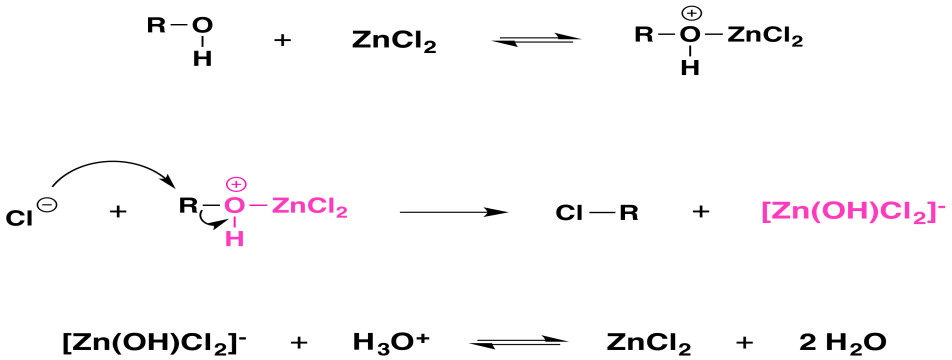
Write the equations for the preparation of 1-iodobutane from 1-butanol. Name the reaction.
Answer
221.1k+ views
Hint: According to the question, we need to perform a reaction using 1-butanol and another reagent to produce 1-iodobutane. To achieve this, we need to substitute the alcohol group, i.e. the –OH group from 1-butanol with iodine.
Complete Step by Step Solution:
We can easily substitute the –OH group with the –I group by using HI as a reagent with the presence of anhydrous ZnCl2.
\[C{H_3} - C{H_2} - C{H_2} - C{H_2} - OH + HI\xrightarrow{{ZnC{l_2}}}C{H_3} - C{H_2} - C{H_2} - C{H_2} - I + {H_2}O\]
Anhydrous ZnCl2 is added with hydrohalic acid for a specific purpose. ZnCl2 is a strong Lewis acid added to the reaction as Cl is considered as a better nucleophile than I. It happens due to its bulky size and Cl makes the alcohol group (-OH) a better leaving ability group than other halides. When alcohols are reacted with a strong Lewis acid, it forms a complex, [Zn(OH)Cl2].
Then in the following rearrangement reaction, the R-Cl product is changed to R-I and thus we get our desired haloalkanes. The reagent used, [HI + ZnCl2] is also known as the Lucas reagent and the reaction is commonly referred to as the Lucas reaction or the substitution of the –OH group.
Additional Information: Lucas reagent is a solution of anhydrous zinc chloride mixed with concentrated hydrochloric acid. This solution is used to identify and classify low molecular weight alcohols. The reaction taking place is a substitution in which the chloride ion replaces a hydroxyl group. If the colour of the solution changes from colourless to turbid with an oily layer on top of the solution, the test for alcohol is positive and it signals the formation of a chloroalkane.
Note: ZnCl2 reacts with the alcohol group in the following mechanism.

Complete Step by Step Solution:
We can easily substitute the –OH group with the –I group by using HI as a reagent with the presence of anhydrous ZnCl2.
\[C{H_3} - C{H_2} - C{H_2} - C{H_2} - OH + HI\xrightarrow{{ZnC{l_2}}}C{H_3} - C{H_2} - C{H_2} - C{H_2} - I + {H_2}O\]
Anhydrous ZnCl2 is added with hydrohalic acid for a specific purpose. ZnCl2 is a strong Lewis acid added to the reaction as Cl is considered as a better nucleophile than I. It happens due to its bulky size and Cl makes the alcohol group (-OH) a better leaving ability group than other halides. When alcohols are reacted with a strong Lewis acid, it forms a complex, [Zn(OH)Cl2].
Then in the following rearrangement reaction, the R-Cl product is changed to R-I and thus we get our desired haloalkanes. The reagent used, [HI + ZnCl2] is also known as the Lucas reagent and the reaction is commonly referred to as the Lucas reaction or the substitution of the –OH group.
Additional Information: Lucas reagent is a solution of anhydrous zinc chloride mixed with concentrated hydrochloric acid. This solution is used to identify and classify low molecular weight alcohols. The reaction taking place is a substitution in which the chloride ion replaces a hydroxyl group. If the colour of the solution changes from colourless to turbid with an oily layer on top of the solution, the test for alcohol is positive and it signals the formation of a chloroalkane.
Note: ZnCl2 reacts with the alcohol group in the following mechanism.

Recently Updated Pages
Difference Between Alcohol and Phenol: Structure, Tests & Uses

Classification of Drugs in Chemistry: Types, Examples & Exam Guide

Class 12 Chemistry Mock Test Series for JEE Main – Free Online Practice

Is PPh3 a strong ligand class 12 chemistry JEE_Main

Full name of DDT is A 111trichloro22bispchlorophenyl class 12 chemistry JEE_Main

Sodium acetate on heating with soda lime produce A class 12 chemistry JEE_Main

Trending doubts
JEE Main 2026: Application Form Open, Exam Dates, Syllabus, Eligibility & Question Papers

Derivation of Equation of Trajectory Explained for Students

Hybridisation in Chemistry – Concept, Types & Applications

Understanding the Angle of Deviation in a Prism

How to Convert a Galvanometer into an Ammeter or Voltmeter

Degree of Dissociation: Meaning, Formula, Calculation & Uses

Other Pages
Solutions Class 12 Chemistry Chapter 1 CBSE Notes - 2025-26

NCERT Solutions For Class 12 Chemistry Chapter 1 Solutions - 2025-26

The D and F Block Elements Class 12 Chemistry Chapter 4 CBSE Notes - 2025-26

NCERT Solutions for Class 12 Chemistry Chapter Chapter 7 Alcohol Phenol and Ether

NCERT Solutions ForClass 12 Chemistry Chapter Chapter 8 Aldehydes Ketones And Carboxylic Acids

JEE Advanced Marks vs Ranks 2025: Understanding Category-wise Qualifying Marks and Previous Year Cut-offs




